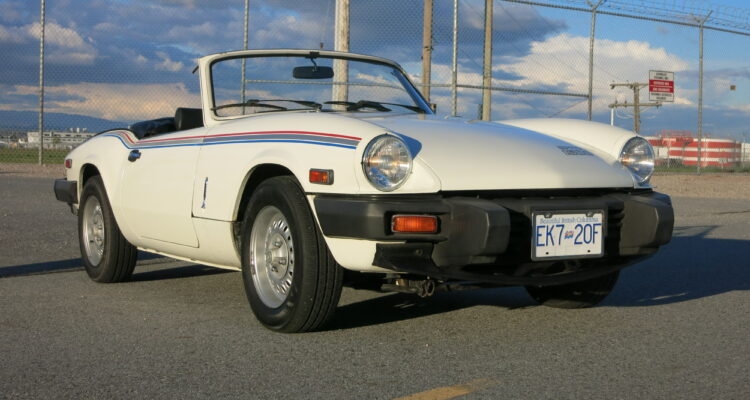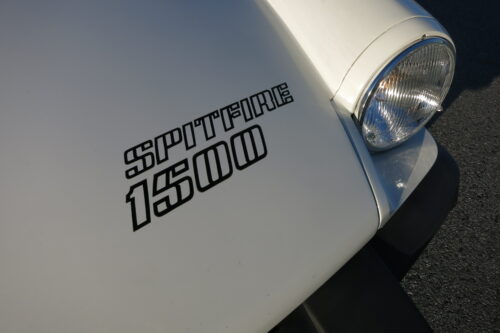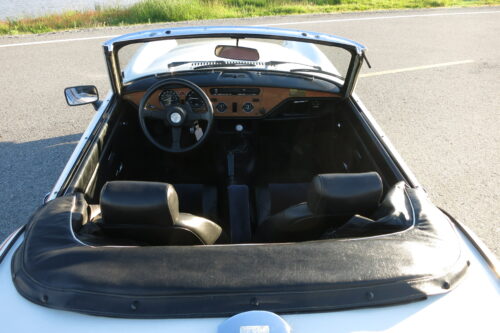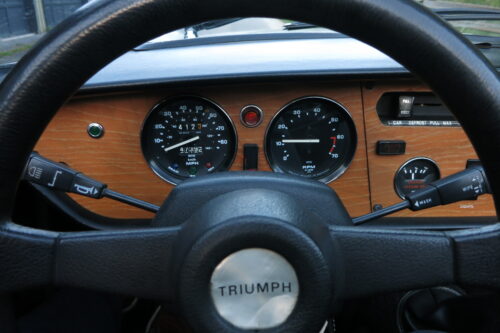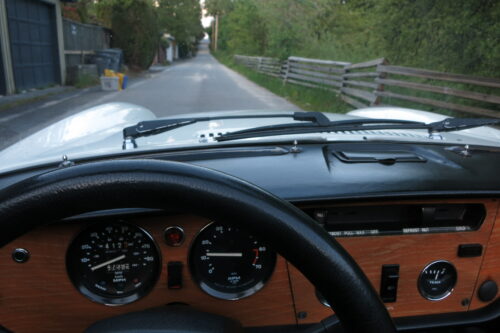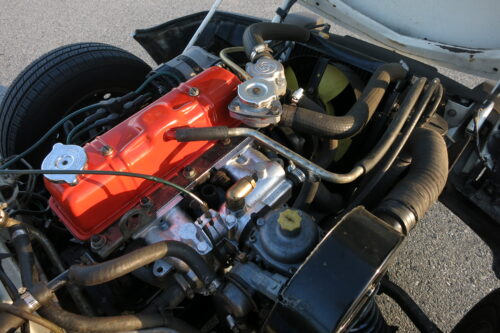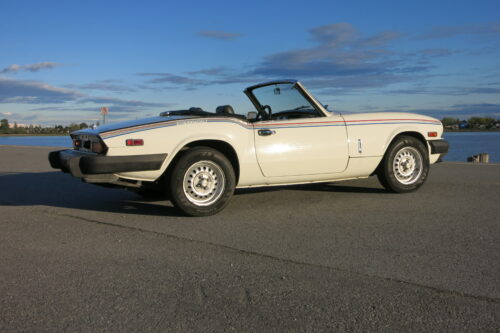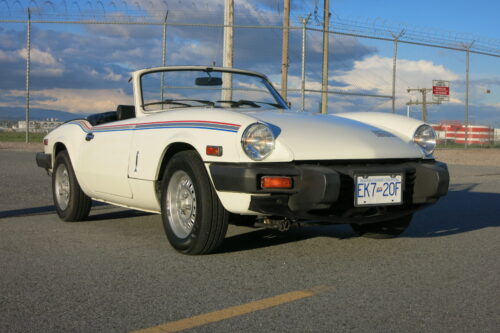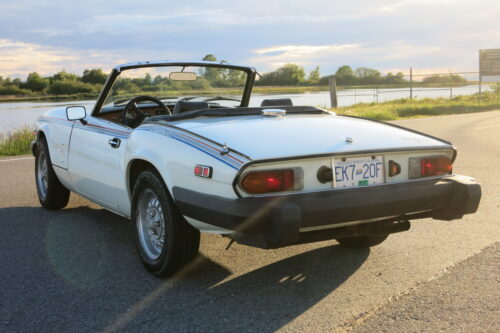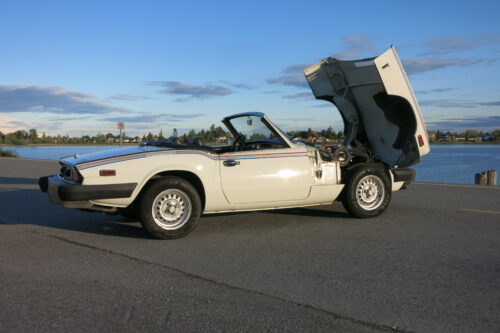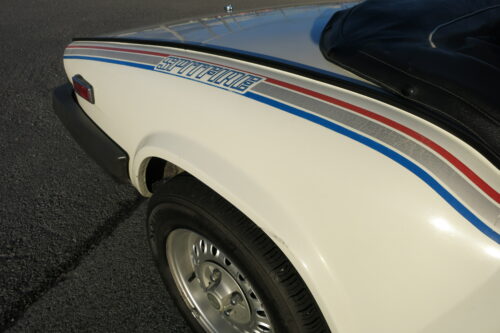You’re looking at an unmolested 1981 Triumph Spitfire 1500 with 47,000 original miles. It was actually manufactured in June of 1980, which was the final year of Spitfire production, but by the time it was on Canadian shores it was considered model-year 1981.
The Spit – as the Brits call them for short – was built in Canley Coventry, England. Production began in 1962 with the Mark I generation, followed in successive intervals by the Mark II, Mark III, and Mark IV.
The 1500 was the last generation Spitfire, named so to reflect an increase in engine displacement to 1493 CCs. The stout little 4-banger was bolted to a 4-speed manual gearbox featuring an optional electric overdrive in third and fourth gears.
Despite being a 1981 vehicle, the subject of this test drive – as with all Spitfires – has manual steering and manual brakes, meaning that there is no power assist in either function. Windows are also manually rolled up and down, something many adults today have never had the joy of cranking.
There are in-fact many facets of this old beauty that bring joy to both young and old. For me, it starts with the lines of its classic-roadster body. Even with the large black bumpers imposed by North American bumper standards in the late 70s, the Spit is svelte and simply gorgeous.
As with its big brother, the Triumph TR6, the Spit in its later years featured a real-wood dash into which jewel-like Smiths analogue gauges were set. Glowing green at night, these dials transcend time.
It’s no secret that British build-quality of the era wasn’t something Churchill would’ve tolerated. Spitfires were prone to rust and their upholstery tended to wear out sooner than a cheap suit. Fortunately, our subject vehicle lived its life in B.C.’s Okanagan Valley in a near desert-like climate rendering it rust-free.
After many months of searching, I was lucky enough to find this vehicle quietly for sale by the owner of Oliver Car and Truck Sales in Oliver B.C. The Spit was Todd’s personal collector car, which he cherished before allowing me to take careful ownership of.
It was hard for Todd to say goodbye to the Spit, but he knows that it’s gone to a home where it’ll be further cherished by a father and son team of car fanatics.
The drive home to Vancouver from Oliver was 430 kilometres. The route took us over mountain passes where we encountered heavy snow, though none sticking to the ground. It was an excellent opportunity to allow the Spit to stretch its legs and work-out the kinks.
I doubt the old girl made many single-day journeys of such length throughout its 36-year life, but it never missed a beat for us, performing like a champ doorstep to doorstep.
So, what’s it like in the cockpit? Cramped comes to mind, and by today’s standards, so does rudimentary and coarse, but that’s part of the charm! Looking out over the Spits hood and its tall rounded fenders is a sight not seen in the modern world.
The low-cut doors allow an elbow to comfortably hang outside the car in a retro James Dean fashion; everyone looks cool in Spit.
There’s lots of noise and vibration as the engine pops and crackles to life. Tapping the metal throttle instantly revs the engine with gusto and an eagerness that only a vintage 4-banger can deliver.
Some deftness of foot is needed to manage the three pedals in the tight foot-well. The tall shift lever falls into gear with the ease of sliding into a well-worn shoe. Releasing the clutch brings about a spirited response as the engine quickly revs up with its staccato signature calling for the next of four cogs.
Those not accustomed to manual steering – often referred to as Armstrong steering for obvious reasons – will find the unfiltered feel of the road to be far different from that of modern power-steering setups. It’s so detailed and revealing, perhaps like brail to an unsighted person.
Steering inputs are reacted to with immediacy worthy of a go-kart. Bringing the Spit to a stop is another enlightening nod to history. Manual brakes require plenty of effort to effect change, but with enough vigor, the Spitfire can be hauled back to zero with nosebleed inducing brevity.
It should be noted that vintage cars don’t compensate for human incompetence with systems such as traction control, antilock braking, and vehicle stability control. All safety nets are internal to the driver, not the car.
When it comes to the true art of driving and the whimsy of stepping back in time, a vintage vehicle is an automotive time machine. There are many pitfalls to ownership, but for those that appreciate raw mechanical functions and seek a visceral experience behind the wheel, there’s nothing better than vintage.



